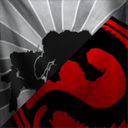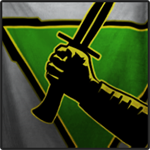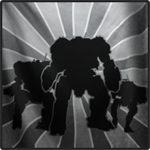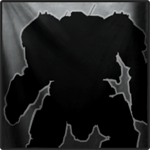Scouting - Reading the Opponent
Before I begin, I want to point out that I'm staying away from base cap plays in this article because the subject has enough scope within itself that it can be the focus of an entirely different article.
Piloting a light mech involves many things, but scouting is a role that is overwhelmingly the domain of light mechs. Scouting seems like a simple activity but the value of the scout and more specifically, the information they give out is highly dependent on both the observational capacity and communication skills the scout pilot has. The way a match plays out is a combination of intentions of both teams before the game starts as well as how the match changes based on how each team has executed and altered their approach throughout the course of the match. What's more, the relationship the scout and the DC have is an important one, so it's not just the scout, but the exchange between the scout and the DC that really maximizes this function.
For KaoS, our deployment is typically a function of 3 major factors: The drop deck, the map we end up with, and what we expect our opponent to do. I've said this before: most of the skilled/intelligent teams will exploit their strengths and countervail or minimize the advantages of their opponent. In order to execute this, you need to have good intel. This is where effective scouting comes in.
For myself, there are a few smaller phases of the initial scouting that happen before a clusterf___ begins. On any given map, I'll have a typical direction I go to scout and it takes me 'X' amount of time to get there. Based on the drop deck, there will obviously be different pacing involved so the first thing to do when bolting down the map is to pay attention to the clock. This is the first major aspect - inference. From the time elapsed and where I've managed to position myself, I can also infer how far my opponents have travelled.
With the timing in mind, it now moves into the second phase - determining location. All the maps have what I'd call 'break-open points' where you hit the apex the map's topography and are given a clear, far-reaching view of the battlefield. I'm sure many of you can think of these points on many maps. The ridge in the middle of Frozen City is an obvious break-open point, If you're on the lake spawn of Caustic Valley, the right side of the map with that well known sniper hill and the ridge in front of it is a massive break-open point. From the refinery side of Caustic Valley, running along the ridge that straddles the 3/4 line, you get a progressive opening of your viewing angle as your view opens up to see the enemy's side of the caldera. Often times, scout groups will run into each other in these areas because it's natural for scouts to want to be in these places so that they can see where the enemy is, and just as importantly, where the enemy is not. This is where the 3rd phase comes in.
Once you've reached where you want to be, this is where you start to really think. If I'm at 'x' breaking-open point and I don't see them, where would they logically be otherwise? Based on the drop decks, where would they want to be? Based on how they play combined with the drop deck, again, where would they want to be? From this point, you're opening up a simultaneous inductive and deductive thought processes. From what you know based on your scouting, what are possible extrapolations of this information. With what you know of the opponent, what kind of positioning can you likely eliminate in order to deduce where they are and what they're doing.
The first 30 seconds of any match presents the scout with lots of enormously useful information, but the scout also needs to be able to interpret it. This is now where the scout/DC communication starts to come in. It's one thing for the scout to hit a break-open point and say "they're not here." Okay, so? What else? When it starts to really matter is when you spot the enemy's force and your main force is still well behind you. A scout who is only performing his or her role at a minimum will say "'x' mechs in this area". When you've spotted the opponents, you start the process you did before in your initial scouting phase.
You've now spotted your opponent; you now have to ask yourself a series of questions in order to paint a clearer picture of what's going on. The first step is to both identify what mechs you've seen, and not just where they are, but where they're going. Not only that, where is the mech(s) you see in relation to the rest of the force? Identifying where the assaults is probably the most critical aspect, because that's the focal point of the opposing team's force. Smaller weight classes have more flexibility to spread out due to their speed and their intended roles, but the location of the assaults is often a giveaway as to overall direction the enemy team plans to head, and it tells me an enormous amount about what they intend to do and where they intend to be, even if I can't read their loadouts.
Understanding not just where the mechs are but where they're going and inferring their intentions from there is what separates a mediocre scout from a good scout. Interpreting your opponent and relaying your observations to the DC so that the DC can process the information and adjust accordingly is critical. A good scout will read the opponent's intentions correctly, and a good DC will adjust to exploit it appropriately. This is why the communication and analytical skills of both the scout and DC are extremely important, and there's a synergy between a good scout and DC because they're making the most of the information in front of them. I often suggest courses of action based on what I see and I function as an extension of the DC sometimes, as a secondary play caller because I've got a lot more information at my disposal that isn't being lost in communication back to the DC.
Now that you've taken enemy movement into consideration, try and get a target lock so you can determine their loadouts. Just like spotting the assaults, seeing the weapons your opponent has on any given weight class says a A LOT about how your opponent intends to fight. Lights are the most cookie-cutter of all weight class, if you see a Raven 3L, you don't need to target it to know that it's carrying 3 medium lasers, 2 streaks, an ECM and an XL 295, so targeting one usually isn't going to tell you anything you don't already know. Because you want to limit the amount of time you're exposed, you want to maximize the information you glean from your opponent. Often times, the best mechs to scout are the heavies. The composition of the heavy mechs says the most about how the enemy intends to play because they have the sharpest division in terms of roles of any weight class. Many teams run mixed heavies with success, but knowing which ones have what will tell you a lot. Heavies have the most dramatic distinction between brawler and sniper setups. Since drop decks are matched, you know how many heavies the opponent has, but you want to know what they're divided into. Often times, knowing your opponent well enough tells you what they're likely to bring, but identifying Cataphract 3D snipers from Catapult K2 AC20 brawlers to Catapult A1 "Bukkakapults" is very important.
The composition of the mediums also says a lot about how any opponent intends to play. Lots of Cicadas and they intend to focus from the bottom up, giving their light game a massive advantage and then working up the weight chain. If they take typical brawlers like Hunchbacks and Centurions, it means their focus is on the heavy side of the battle, and they intend to win top down. This also means they'll probably be more aggressive once they're in a position that suits them. A team with Cicadas will naturally play more conservatively, trying to overpower your lights before being comfortable with going with an all-out engage.
With some of these things in mind, a team can dramatically improve its positioning and make the most of what they brought to the fight. Make sure there's a strong emphasis on reading your enemy and that both your scouts and your DC are adjusting accordingly. I've seen many matches that were won before the first shot was even fired.
Edited by GaussDragon, 09 March 2013 - 08:41 AM.






























